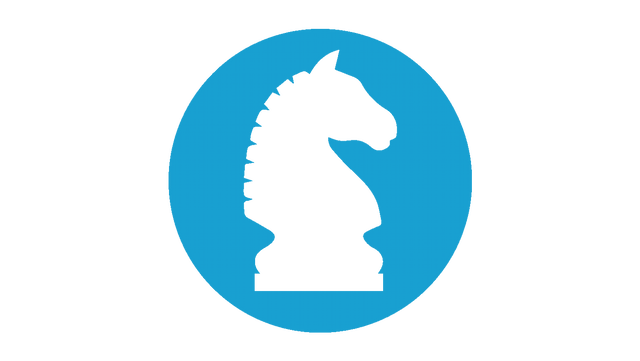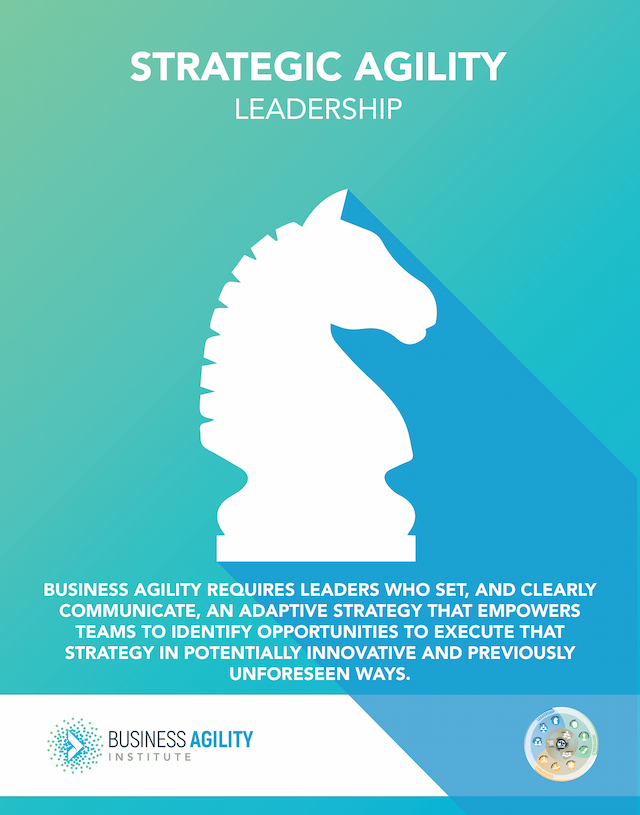Domains of Business Agility
- Customer
- / Customer
- Leadership
- / People Management
- / One Team
- / Strategic Agility
- Individuals
- / Growth Mindset
- / Craft Excellence
- / Ownership & Accountability
- Operations
- / Structural Agility
- / Process Agility
- / Enterprise Agility

Strategic Agility
01 Introduction
Business Agility requires leaders who set, and clearly communicate, an adaptive strategy that empowers teams to identify opportunities to execute that strategy in potentially innovative and previously unforeseen ways.
Organizations have always needed to earn the right to exist. Yet, as both market predictability and the barrier to entry is decreasing, we are now seeing that incumbents no longer enjoy the same commercial advantage as they used to. It is agile organizations — those that frequently inspect, adapt and pivot to meet opportunities — that are more likely to flourish in this ambiguous and uncertain market. Speed and effectiveness of this adaption to competitors, disruptors, and new customer demands are key measures of Strategic Agility.
Gone are the five year plans favored by 1980’s management consultants. Organizations have realized that strategy, as we have tended to practice it is yesterday’s news. Instead, we have a five year vision, an emergent strategy, and continuous planning. The difference is an approach to strategy which enables us to continually probe the market and try new strategies to adapt to the changing customer demands.
Be careful to fall into the trap of superficial innovation though. Being innovative means taking risks. It means accepting, and being ready for failure. It means second-guessing your own customers in some instances. Kodak is probably the poster child for doing, but not being, innovative. They invented the digital camera but did not feel the market was ready and were not willing to take the risk of hurting their print partners and so did nothing. Now there is a digital camera everywhere, and most of them aren’t Kodak’s.
A side note: Innovation doesn’t necessarily mean doing something brand new. It can be doing something old in a new way or with a new market. But, by definition, it is a risk. Apple took the Xerox Parc prototype GUI interface and put it successfully inside an innovative personal computer. Google took the idea of a social network and created an unsuccessful product called Google+. Both these companies didn’t invent the idea. They tried it, either successfully or unsuccessfully, in a new way.
Some of the key characteristics of market agility include;
- Rewarding ideas, especially if they fail.
- Define KPIs around the result of an experiment (not just success).
- Finance and procurement processes support ambiguity and uncertainty in market innovation before investing.
- Short feedback loops to determine the real market reality of the idea
- Teams need to be able to talk directly, and frankly, to users/clients about their experiences
Building a culture of innovation is hard. It has to be embedded throughout your entire organization. Something that many organizations struggle with. One example is the Kickbox from Adobe. On the surface, this is a great idea. Anyone can request the box: inside is all the information needed on how to turn an idea into an experiment, a Starbucks gift card, and (the brilliant part) a $1,000 credit card to spend on anything you like. But here’s the problem, Adobe is effectively saying that their internal procurement processes are so counterproductive to innovation that they need to bypass them entirely. Kudos to them for recognizing the problem and coming up with a workaround, but for the organization to truly “be” innovative, it has to go deeper.
Once we include the connection to the market in the wider systemic perspective of business agility, our view of customer value extends to include the entire value chain, from your suppliers upstream to your distributors downstream. The partnerships that this systemic perspective grants result in the creation of superior offerings that delight your customers. Methods and frameworks like Lean Startup, Lean Enterprise, Design Thinking, and many traditional agile practices fall under this domain.
02 Moving from Theory to Practice
Your goal is to create a viable market strategy within an ambiguous, unpredictable and uncertain market.
Set a Clear Market Vision
An organization is given the mandate to operate in the market by the customer. Logically, your current products and services must be aligned to the needs of your customers. Yet, the strategy and vision of your organization must be aligned to the needs of your future customers. This vision serves two purposes. The first is the development of a strategic direction for the organization to remain relevant in the market. The second is to inspire people towards a common goal for the future.
Emergent Strategy
Strategy is no longer a five-year plan designed in a boardroom with the top executives and a couple of consultants. Rather strategy needs to emerge from a continuous understanding of the changing operational landscape as it aligns to the business vision. Leaders need to remain actively engaged with teams & their customers to adjust strategy and business outcomes regularly. In fast-moving markets, run strategic planning workshops at least every 60 days. Because emergent strategy is usually incremental, rather than a major shift, communication of the strategy, and the subsequent execution of it, does not add extra overhead to the operation of the business.
Market Creating Innovations
The discovery and exploitation of new market opportunities are fundamental to strategic agility. Steve Denning calls these “Market Creating Innovations”. He says: “Market creating innovations are innovations that open up markets which didn’t previously exist.” The mandate that an organization has to operate in a market is, by its very nature, transient. Companies do not have the luxury of market dominance with a single product anymore.
03 Measuring your Business Agility Maturity
Crawl
Walk
Run
Fly
Market Experimentation
Divisions put forward project business cases for innovative products and/or services. New teams are formed and funded to deliver on this project.
We have dedicated teams focusing on innovation who are, potentially, using practices like Hypothesis Testing, Lean Start-up and Design Thinking.
We measure adaptation effectiveness to new customer demands (against competitors and disruptors). We use this information in our short-term business strategy.
Hypothesis Testing (e.g. Lean Start-up) or similar innovation practices are being used across all divisions. Innovation is everyone’s responsibility, not just a dedicated team.
Vision
Leaders in our organization communicate a clear vision. Yet, how work aligns to that vision is unclear or theoretical.
It is clear how most work aligns to the organizational vision.
Leaders align our organization to a single, collectively defined, vision. Everyone in the organization is clear on their role in that vision and how they connect to everyone else.
Leaders actively and consistently invest time to clarify our vision. Teams use this as a tool for alignment and decision making.

